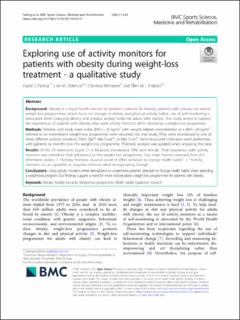| dc.contributor.author | Følling, Ingrid Sørdal | |
| dc.contributor.author | Oldervoll, Line Merethe | |
| dc.contributor.author | Hilmarsen, Christina Wikstrøm | |
| dc.contributor.author | Ersfjord, Ellen Margrete Iveland | |
| dc.date.accessioned | 2021-04-16T07:57:29Z | |
| dc.date.available | 2021-04-16T07:57:29Z | |
| dc.date.created | 2021-04-08T09:41:19Z | |
| dc.date.issued | 2021 | |
| dc.identifier.citation | BMC sports science, medicine and rehabilitation. 2021, 13, . | en_US |
| dc.identifier.issn | 2052-1847 | |
| dc.identifier.uri | https://hdl.handle.net/11250/2738021 | |
| dc.description.abstract | Background
Obesity is a major health concern in western countries. In Norway, patients with obesity can attend weight-loss programmes, which focus on changes in dietary and physical activity habits. Use of self-monitoring is advocated when changing dietary and physical activity habits for adults with obesity. This study aimed to explore the experiences of patients with obesity who used activity monitors while attending a weight-loss programme.
Methods
Patients with body mass index (BMI) > 35 kg/m2 with weight related comorbidities or a BMI > 40 kg/m2 referred to an intermittent weight-loss programme were recruited into this study. They were introduced to one of three different activity monitors, Fitbit Zip™, Mio Fuse™, or Mio Slice™. Semi-structured interviews were performed with patients six months into the weight-loss programme. Thematic analysis was applied when analysing the data.
Results
Of the 29 informants (aged 21 to 66 years) interviewed, 59% were female. Their experience with activity monitors was related to their adherence to the weight-loss programme. Two main themes emerged from the informants stories: 1. “Activity monitors visualize proof of effort or failure to change health habits”. 2. “Activity monitors act as a positive or negative enforcer when incorporating change”.
Conclusions
Using activity monitors either strengthens or undermines patients’ attempts to change health habits when attending a weight-loss program. Our findings suggest a need for more individualized weight-loss programmes for patients with obesity. | en_US |
| dc.language.iso | eng | en_US |
| dc.publisher | BioMed Central | en_US |
| dc.rights | Navngivelse 4.0 Internasjonal | * |
| dc.rights.uri | http://creativecommons.org/licenses/by/4.0/deed.no | * |
| dc.title | Exploring use of activity monitors for patients with obesity during weight-loss treatment - a qualitative study | en_US |
| dc.type | Peer reviewed | en_US |
| dc.type | Journal article | en_US |
| dc.description.version | publishedVersion | en_US |
| dc.source.volume | 13 | en_US |
| dc.source.journal | BMC sports science, medicine and rehabilitation | en_US |
| dc.identifier.doi | https://doi.org/10.1186/s13102-021-00253-9 | |
| dc.identifier.cristin | 1902895 | |
| dc.description.localcode | This article is licensed under a Creative Commons Attribution 4.0 International License, which permits use, sharing, adaptation, distribution and reproduction in any medium or format, as long as you give appropriate credit to the original author(s) and the source, provide a link to the Creative Commons licence, and indicate if changes were made. The images or other third party material in this article are included in the article's Creative Commons licence, unless indicated otherwise in a credit line to the material. If material is not included in the article's Creative Commons licence and your intended use is not permitted by statutory regulation or exceeds the permitted use, you will need to obtain permission directly from the copyright holder. To view a copy of this licence, visit http://creativecommons.org/licenses/by/4.0/. The Creative Commons Public Domain Dedication waiver (http://creativecommons.org/publicdomain/zero/1.0/) applies to the data made available in this article, unless otherwise stated in a credit line to the data. | en_US |
| dc.source.articlenumber | 25 | en_US |
| cristin.ispublished | true | |
| cristin.fulltext | original | |
| cristin.qualitycode | 1 | |

